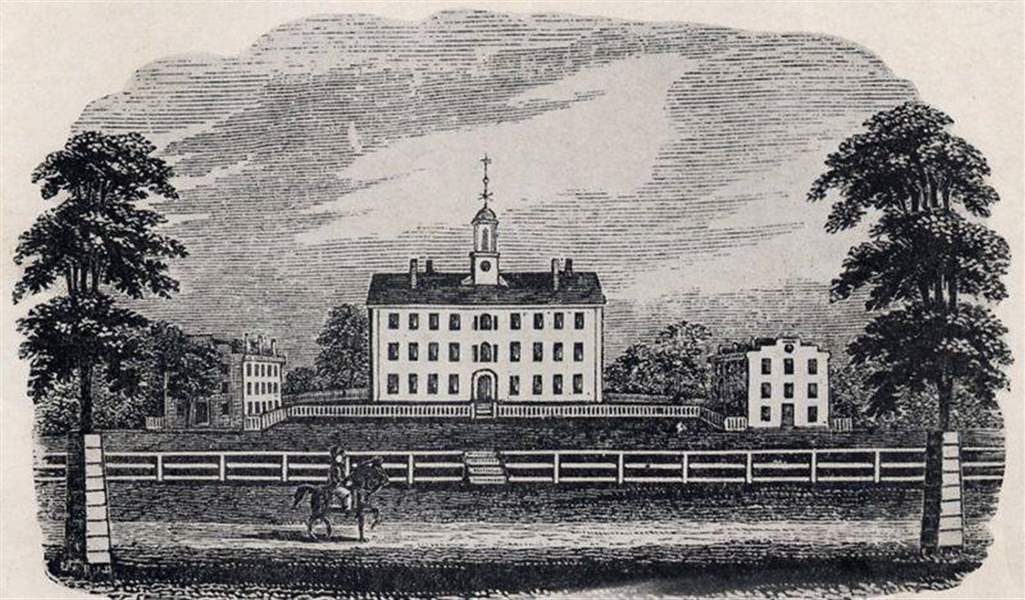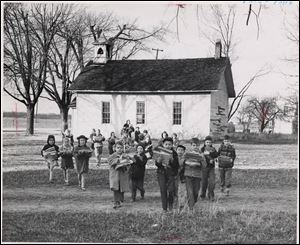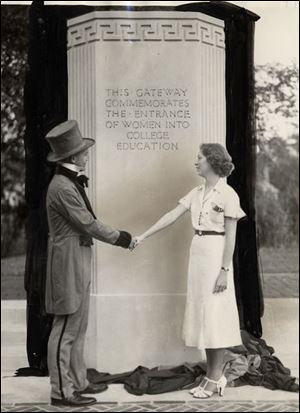
State's commitment to education dates to 1785 Land Ordinance
3/2/2003
An 1846 drawing by Henry Howe shows Cutler Hall at Ohio University in Athens. Construction began in 1816 and was finished in 1819.

First and second grade pupils in 1950 carry school supplies from their old one-room school house in Riley Township across the field to a new school.
Ohio's educational history began before its statehood.
The Land Ordinance of 1785 set aside spaces for schools in the then-unsurveyed lands of the westward areas — a provision that first provided for Ohio's one-room schoolhouses and eventually led to today's high-tech university complexes.
In the years since then, several themes in Ohio education have emerged and continued to influence how students are educated from pre-school to graduate school, said Malcolm Campbell, a retired professor at Bowling Green State University whose research and teaching career was dedicated to the history of education in Ohio.
Debates about where schools should be placed within communities began during the Continental Congress and continue today as districts throughout Ohio partake in a massive school rebuilding effort. The 1785 ordinance contained a provision that committed Section No. 16 in each township “for the maintenance of public schools within the said township.”
The Northwest Ordinance in 1787 stated that: “Religion, morality, and knowledge being necessary to good government and the happiness of mankind, schools and the means of education shall forever be encouraged.”
That gave birth to education in Ohio and continued debates, according to Dr. Campbell. “It gave education a rhetorical flourish,” he said.

At Oberlin College in 1937, student descendents of America's first coeds mark the 100th anniversary of coeducation, which began there.
During the Progressive Era of the late 19th and early 20th centuries, educational reformers successfully argued that schools should be designed as vehicles of social change and as places that develop the citizenry.
Today's superintendents, university presidents, and some lawmakers urge school reform to prepare students for the workplace. Proficiency tests at three grade levels test citizenship, demonstrating a continuing priority of policymakers on civics knowledge.
Urban and rural schools squared off and vied for public support of each system, and poorer districts always have complained about insufficient support from the state as compared to the more affluent districts, according to Dr. Campbell.
Ohio has had several national firsts in education, perhaps the most notable being the establishment of Ohio University in Athens, Ohio, as the country's first college established by land grant in 1804.
“Sometimes it was referred to as a college, and sometimes it was referred to as a seminary,” in its early days, said Doug McCabe, Ohio University's curator of manuscripts, adding that the school was founded by Presbyterians.
When Ohio University opened in 1808, just three students attended what wasn't much more than a “glorified high school,” Mr. McCabe said. “There just weren't grade schools and high schools as we think of them today, so there weren't people in this area of Ohio in the early years able to have the opportunity to go to school to be prepared to go to college,” he said.
Still, the early commitment to higher education in the state led to the post-Industrial Revolution development of specialized and professional degrees, Mr. McCabe said.

An 1846 drawing by Henry Howe shows Cutler Hall at Ohio University in Athens. Construction began in 1816 and was finished in 1819.
Other notable — if lesser known — firsts in Ohio's educational history include:
Ohio's libraries, universities, and museums continue to collect and catalog letters, diaries, records, published works, furniture, and other historical items related to the state's educational history, said Barbara Floyd, archivist and director of Ward M. Canaday Center, the University of Toledo's special collections department.
“What you learn is that the University of Toledo, for example, sits within the context of the bigger picture of education in Ohio,” Ms. Floyd said. “Anything that happened in education overall is reflected in our story as well.”